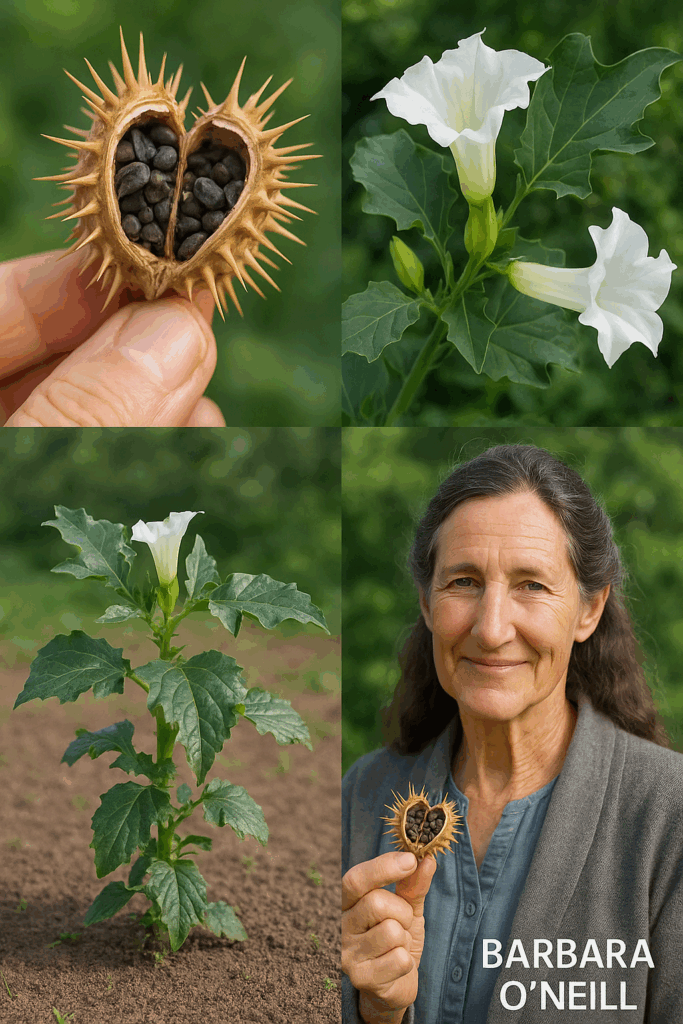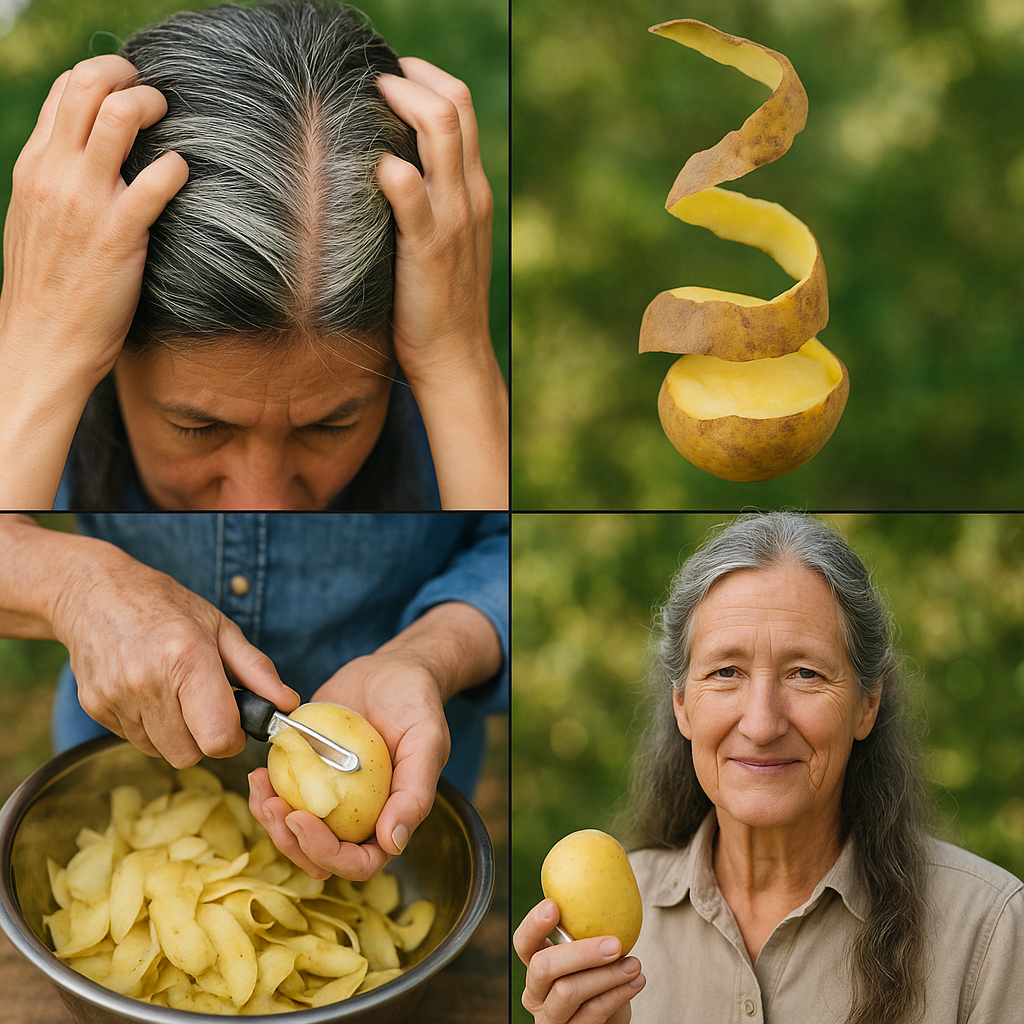🌸 They may look like magical flowers straight out of a fairy tale, but hidden behind Datura’s delicate trumpet blooms lies one of nature’s most dangerous secrets. Known as Devil’s Trumpet or Thorn Apple, Datura plants are stunning—and incredibly toxic. A single encounter can lead to life-threatening consequences.
Here’s why you must keep your distance and protect your home, pets, and loved ones from these deceptively beautiful killers.

🌿 What Exactly Is Datura?
Datura belongs to the Solanaceae family, commonly called the nightshade family. Native to the Americas but now found across the globe, these plants thrive in disturbed soils, roadsides, abandoned fields, and even unsuspecting gardens.
What makes Datura stand out are its massive, trumpet-shaped flowers in shades of white, purple, or yellow and its spiky, thorn-covered seed pods. Their exotic appearance can be mesmerizing—but make no mistake, every part of this plant is dangerously poisonous.
Even casual contact or minor ingestion can cause severe poisoning. Knowing how to identify and avoid Datura is critical for your safety.
🛑 Common Species of Datura You Must Recognize
🔹 Datura stramonium (Jimsonweed or Thorn Apple)
Large white or purple trumpets and wickedly spiny seed pods mark this notorious species. Its reputation for causing intense hallucinations has led to both fatal poisonings and historic incidents of mass delirium.
🔹 Datura metel (Horn of Plenty)
With lush white, yellow, or purple flowers, Datura metel is sometimes grown for its ornamental beauty. However, traditional uses in herbal medicine come with grave risks, and misuse can quickly turn deadly.
🔹 Datura inoxia (Moonflower)
Don’t confuse this plant with the harmless ornamental Moonflower vine. Datura inoxia blooms at night with a heavy, sweet fragrance—and holds a potent concentration of toxins in both seeds and flowers.
🔹 Datura ferox (Long-spined Thorn Apple)
Among the most toxic, Datura ferox is distinguished by larger, fiercer spines on its seed pods. A small amount of its alkaloids can cause immediate and severe poisoning.
⚡ What Makes Datura So Lethal?
Hidden inside every flower, leaf, seed, and stem are powerful tropane alkaloids:
- Atropine
- Scopolamine
- Hyoscyamine
These chemicals disrupt the central nervous system, and even tiny doses can unleash terrifying symptoms that quickly spiral into medical emergencies.

🚨 Symptoms of Datura Poisoning: Warning Signs You Must Know
👁️ Hallucinations and Delirium
Victims often experience vivid, terrifying hallucinations that feel inescapably real.
👀 Dilated Pupils and Blurred Vision
Extreme sensitivity to light and inability to focus are early signs of serious trouble.
👄 Dry Mouth and Difficulty Swallowing
As atropine kicks in, salivary glands shut down, causing intense dryness and choking sensations.
❤️ Rapid Heartbeat and High Blood Pressure
Cardiovascular strain can trigger heart attacks, strokes, and sudden collapse.
🧠 Seizures, Coma, or Death
In severe cases, respiratory failure and coma set in rapidly without intervention.
One mistake is all it takes. Touching your mouth or eyes after handling the plant, inhaling airborne particles, or simply brushing against it can put you in danger.
🐾 Datura: A Silent Threat to Pets and Livestock
Dogs, cats, horses, cattle—all are at extreme risk if they encounter Datura. Just a nibble of a flower or seed pod can lead to sudden illness and death.
Protect your animals:
- Remove Datura immediately from any garden or field they can access
- Always monitor pets when outdoors in unfamiliar environments
- Learn to recognize Datura’s distinct flowers and seed pods
🛡️ How to Stay Safe Around Datura
🧤 Never Touch Without Protection
If you must handle Datura for removal, always wear thick gloves and avoid touching your face.
🚫 Keep Children and Pets Far Away
Children are especially drawn to the colorful flowers and unusual seed pods—teach them early that these are dangerous.
🏡 Eradicate Carefully
When removing Datura from gardens, uproot the entire plant and dispose of it securely. Burning is not recommended, as the smoke can carry toxins.
📚 Educate Your Community
Share knowledge with neighbors, friends, and family. The more people who know, the safer everyone becomes.
⚠️ Why You Should Absolutely Avoid Datura
🌿 Even Tiny Amounts Are Deadly
It doesn’t take much. A handful of seeds or a bite of a leaf can trigger irreversible poisoning.
🌿 Unpredictable Potency
No two plants have the same alkaloid concentration, making effects impossible to predict and extremely dangerous.
🌿 No Safe Way to Use It at Home
Despite traditional uses in folklore and ancient medicine, there is no safe, home-approved method for Datura consumption or application.
Your best protection? Admire from afar—and never underestimate the danger.
🌟 Final Words: Beauty Isn’t Always Safe
Datura is a chilling reminder that nature, while beautiful, demands respect and caution. If you spot this plant, resist the urge to get close. Treat it as you would any serious threat—with awareness, protection, and swift action.
Your health, your pets’ safety, and your peace of mind are worth it.
🚫 Stay alert. Stay protected. Stay far away from Datura.


